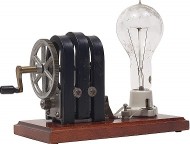 If you mention to anyone that you are planning or going off the grid, the first thing (and sometimes only thing) that comes to most peoples mind is ditching the power company. Some individuals I have talked with in the past get a funny little gleam in their eyes & talk about “sticking it to the man, no more $300 electric bills…” This generally ends up with one of three general outcomes; the bulk of them you will still find on the grid & that little gleam is gone. The next group is still connected to the grid, but they smile contentedly when the sun is shining or the wind is blowing. The final group, well they are rare, but quite simply say, “I wouldn’t have it any other way”.
If you mention to anyone that you are planning or going off the grid, the first thing (and sometimes only thing) that comes to most peoples mind is ditching the power company. Some individuals I have talked with in the past get a funny little gleam in their eyes & talk about “sticking it to the man, no more $300 electric bills…” This generally ends up with one of three general outcomes; the bulk of them you will still find on the grid & that little gleam is gone. The next group is still connected to the grid, but they smile contentedly when the sun is shining or the wind is blowing. The final group, well they are rare, but quite simply say, “I wouldn’t have it any other way”.
Basically, there are 5 main ways that power is generated in this country and are applicable to going off the grid; Solar, Wind, Hydro, Combustion, and Geo-Thermal. Before we get to those options, and seeing this series is about going Off-Grid in the 21st Century, what does it realistically take, I am pretty sure you want to be in the “I wouldn’t have it any other way” group. So maybe we should first look at why many don’t ever reach that point so we can find some solutions on how to get there from here.
The three main gotcha’s:
Cost: While solar / wind / hydro / geo-thermal energy maybe free, getting to be able to harness it, isn’t… Basically you have now just become the power company, so you have to create the power producing unit, run the lines and also maintain it. In many cases, you are looking at paying for the next ten to twenty years’ worth of utility bills up front instead of over time. The nice thing though is, once you have reached that break-even point, the power produced from that point forward is basically free (minus any ongoing maintenance costs), and you don’t have to worry about any future rate increases.
Location & Regulations: Ahhh location, location, location – that means everything in real estate & harnessing power. It doesn’t do you any good if the sun is shining, but your solar cells are shaded. In some cases, you might have a great location for that wind turbine, solar cells, or maybe even a river that can produce enough electricity, but those pesky regulators are standing in your way. Both of these are major factors if you are considering taking an existing house off the grid as you may not have the best orientation, or the power loss from putting XY or Z over there may be too much. If you are starting from scratch, much of this can be mitigated by the initial design which we will address more in future articles.
Storage / Backup Power: Solar power generally works great during the day, but at night an interesting thing occurs – there is no power being generated. While Chicago maybe known as the windy city, the wind isn’t always blowing. This leads us to one reason why many people that still want to move forward, stay connected to the grid – the additional costs and issues associated with installing a bank of batteries and chargers, or running a generator as needed. In today’s technology driven society, I would strongly consider looking at having a UPS (Uninterruptable Power Supply) system that produces “clean” power take care of the electrical distribution for the house, instead of relying on the older system with banks of batteries, inverters, and chargers tied into the main panel.
Moving Forward:
So how does one get past those additional challenges? In many cases, there isn’t much that one can do about the regulations, but the associated costs of the system can be minimized by reducing the size required through better design and material choices. There are also numerous Federal, State and utility rebate programs / tax credits out there to help you reduce your cost to install it. The very next step is to perform an INITIAL sizing, to not only help you determine the size needed, but what type of system(s) you may require and this will be covered in the next article.
Additional Websites & Information:
- Database of State Incentives for Renewables & Efficiency (DSIRE)
- Wall Street Journal – Financing Options
